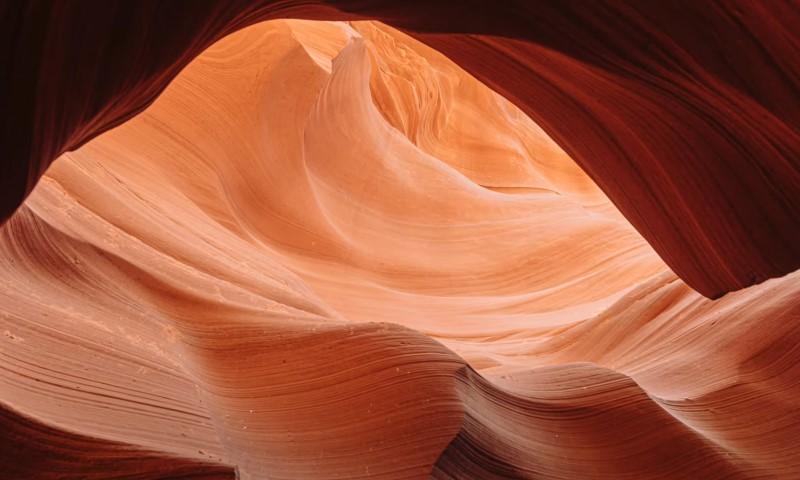Few landscapes in the American Southwest stir as much awe as Antelope Canyon. Hidden in the red sandstone near Page, Arizona, this narrow slot canyon has become one of the most photographed places in the world.
Its smooth, sculpted walls seem to flow like water, glowing in shades of orange, gold, and purple. But before you can wander through its twisting passages, you face one question: Upper or Lower?
Both parts of Antelope Canyon are inside the Lake Powell Navajo Tribal Park, and both can only be visited on a guided tour led by authorized Navajo guides.
They’re close in location but feel very different in person.
Let’s break it down so that you know what to expect once you’re there.
Quick Take on How to Choose
If you want a one-minute answer:
- Go Upper if you dream of the famous light beams, prefer a flat walk, or are traveling with kids or anyone with mobility concerns.
- Go Lower if you like adventure, don’t mind climbing stairs, and want a more active experience with fewer crowds and more varied light.
Both are beautiful. You can’t go wrong, but you can pick the one that matches your comfort level and priorities.
Antelope Canyon Is Guided Only
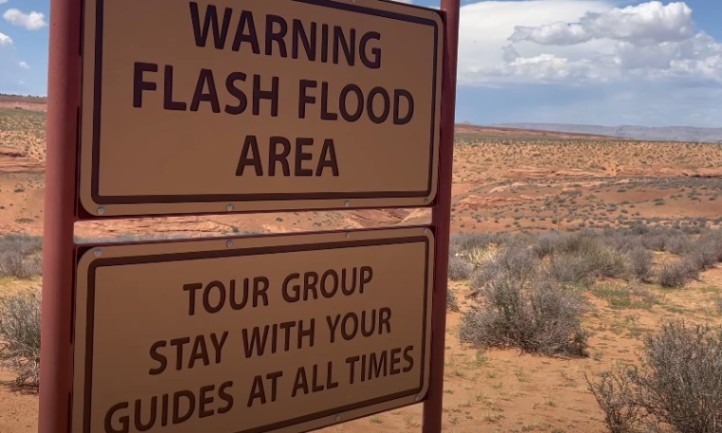
No matter which section you choose, you’ll need to book a guided tour. All tours are operated by authorized Navajo companies.
Prices vary by operator and time slot, but expect around $90-100 USD for Upper Antelope and slightly less for Lower, plus an $8 Navajo Park entry fee per person, per location, according to Navajo National Parks. Some companies include that fee in the total, while others add it at check-in.
Keep in mind:
- You must join a guided tour. Self-guided entry isn’t allowed.
- The park fee applies to each canyon separately.
- Drones, pets, and firearms are prohibited anywhere on Navajo Nation lands.
Upper vs Lower
Both parts of Antelope Canyon are unforgettable, but they offer very different kinds of encounters. Here’s what each one actually feels like once you step inside.
Terrain and Accessibility
Upper Antelope Canyon is shaped like an “A” – wide at the base and narrow at the top. You walk directly through the canyon on flat, sandy ground.
The main challenge is the heat and occasional dust, not climbing. To reach the entrance, you’ll ride in a high-clearance truck from Page (often open-air), then walk through the slot at a relaxed pace.
Lower Antelope Canyon is shaped like a “V” – narrow at the bottom and wider at the top. You enter by climbing down metal stairs into the canyon floor, then continue through tight passageways that twist and curve.
There are several staircases and short ladders inside. Visitors often describe it as more active and fun, but you’ll need to be comfortable with heights, narrow spaces, and climbing stairs.
| Factor | Upper Antelope Canyon | Lower Antelope Canyon |
| Shape | “A”-shaped, wider base | “V”-shaped, narrower base |
| Terrain | Flat sandy walk | Ladders and stairs |
| Difficulty | Easy | Moderate |
| Accessibility | Good for all ages | Requires agility |
| Transport | Truck ride from Page | Short walk from parking lot |
If you have limited mobility, small children, or simply want an easy walk, Upper is the more accessible choice. Lower is better for travelers seeking a bit of physical engagement.
Light, Color, and the Famous Beams
View this post on Instagram
The most famous images of Antelope Canyon, the glowing shafts of light shining through the ceiling, come from Upper Antelope Canyon .
The beams occur when sunlight passes through small skylights and hits the sandy floor, usually between 10:30 a.m. and 1:00 p.m. , from roughly May through September .
Your guide will often help by tossing sand into the air to make the beams more visible. It’s breathtaking when it happens, but also means the canyon gets crowded during those hours.
Lower Antelope Canyon , on the other hand, doesn’t usually have those concentrated light beams. Instead, the light filters in from different angles throughout the day, creating a mix of soft reflections and warm glows.
| Lighting Comparison | Upper Antelope Canyon | Lower Antelope Canyon |
| Signature Feature | Iconic vertical light beams | Soft reflected glow |
| Best Time | Late morning in summer | All day, changing angles |
| Photography Mood | Dramatic, high contrast | Subtle, colorful, textured |
Crowds and Pace
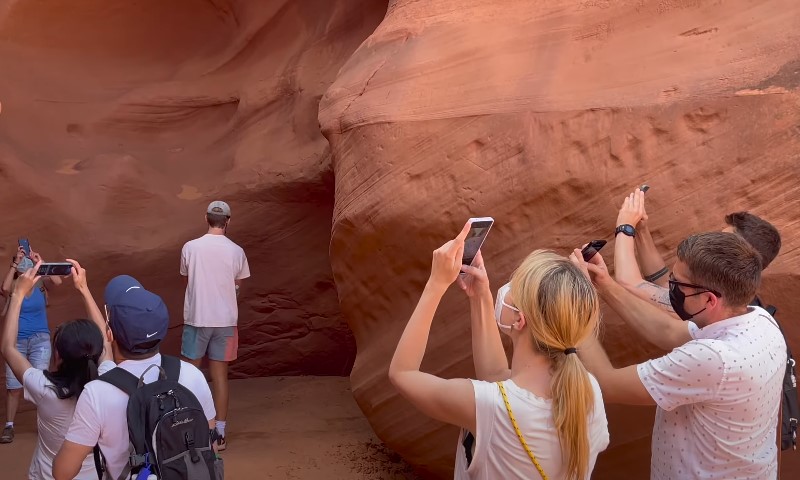
Upper Antelope Canyon is by far the more famous one, which means it’s usually the more crowded.
During light-beam season, it can feel busy, especially in midday slots. Tours run like clockwork; guides manage the flow carefully, but you’ll still be moving through alongside several groups.
Lower Antelope Canyon also books up, but its structure naturally spreads people out. The ladders and curves act like small bottlenecks that separate groups, so you’ll sometimes get quiet stretches between turns.
It feels more spontaneous and less choreographed, though still very much a guided experience.
Price, Duration, and What’s Included
Tour prices change with season, time of day, and demand. Expect higher rates for midday Upper Antelope tours during light-beam season, and slightly lower for early morning or off-season slots.
| Feature | Upper Antelope Canyon | Lower Antelope Canyon |
| Typical Tour Price | Around $92–$125 (base) | Around $80–$110 (base) |
| Duration | 1.5–2 hours (includes truck ride) | 1.5–2 hours |
| Navajo Park Fee | $8 per person | $8 per person |
| Prime Slots | 10:30 a.m.–1:00 p.m. | Early morning or afternoon |
| Tour Type | Sightseeing (photo tours discontinued for most) | Active sightseeing |
Always check whether the park fee is included before booking. Some operators will bundle it, others will not.
If you paid the fee at another Navajo park earlier in the same day (like Horseshoe Bend Overlook or Antelope Canyon X), some companies may credit it if you show your receipt, always confirm ahead of time.
Safety
Antelope Canyon’s beauty exists because of flash floods, and those same floods still shape it. Rainstorms, even far away, can send torrents through the slots with little warning.
When weather risk is high, tours are postponed or canceled outright. Guides take no chances. If your tour is canceled due to weather, it’s to keep everyone alive.
Photography and Gear Rules
Each operator sets its own rules, but generally:
- Tripods and monopods are not allowed on standard sightseeing tours.
- Large camera bags, drones, and selfie sticks are also prohibited.
- Phones and small cameras are fine, and modern stabilization handles low light well.
Upper Antelope’s light beams can be tricky to shoot because of high contrast, while Lower’s diffused light is softer and easier for most cameras.
Bring a microfiber cloth to wipe off sand and dust, and store your gear in a simple zip bag when not shooting.
Comfort and Fitness
Both canyons require moderate walking, but they differ in how physical they feel.
- Upper : Flat sandy walk, no climbing, dusty and warm. Suitable for most travelers who can walk on uneven surfaces for 30-40 minutes.
- Lower : Several staircases and narrow squeezes. You’ll descend and climb multiple times. Good shoes and basic fitness are a must.
Wear
- Closed-toe shoes with grip.
- Lightweight clothes, layers in cooler months.
- A hat and sunscreen for the approach area.
Bring
- A small bottle of water if allowed (some operators restrict it).
- A microfiber cloth for your camera or phone.
- Minimal gear to stay within bag-size rules.
When To Go
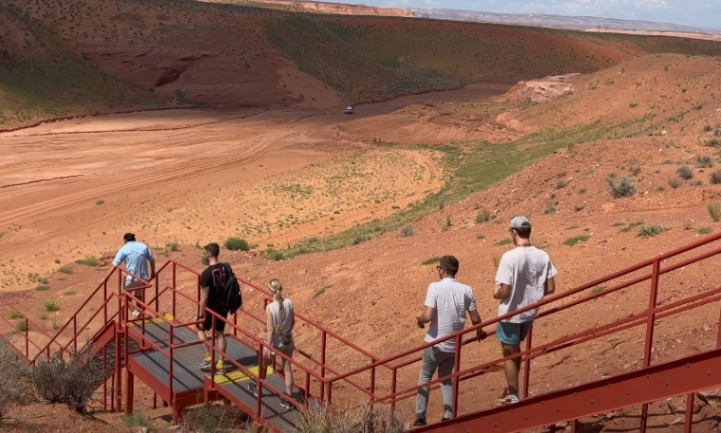
Timing matters, especially if you want those famous light rays.
For Upper Antelope
- Best light beams: May-September , between 10:30 a.m. and 1:00 p.m.
- Expect crowds and higher prices.
For Lower Antelope
- Beautiful light year-round.
- Early morning or late afternoon offers great tones and fewer people.
- Shoulder seasons (spring and fall) balance comfort and crowd levels.
Weekdays are generally calmer than weekends, and off-season (winter) brings smaller groups but less intense sunlight.
Booking Smart
Antelope Canyon is popular year-round, so planning ahead helps.
- Book early. Prime slots can sell out weeks ahead, especially in summer.
- Use authorized operators. The Navajo Nation lists them officially; avoid third-party resellers.
- Check what’s included. Look for details on the park fee, transport, and cancellation policies.
- Stay flexible. The weather can change plans. Leave room in your schedule.
- Mind the rules. Bag size, no tripods, and no drones are standard restrictions.
What To Wear and Bring
@amymarietta 5 things to know before visiting antelope canyon, arizona 1. you can’t go without a guide. you have to book a tour ahead of time because they book up weeks in advance – i recommend antelope canyon x tours because it’s less crowded, untouched, and the navajo guides are so knowledgeable and cool. my guide nick had iPhone tips and was also a really great photographer which was such a plus. 2. they say the best lighting for photos is from 10:30 am – 1 pm 3. you can’t bring any bags unless they are clear 4. the closest town to stay near here is page, arizona which is by lake powell so you can start your morning in antelope canyon, drive around lake powell, then end your day watching sunset at horseshoe bend grand canyon. 5. you take a shuttle out so don’t worry about wearing “hiking gear” it’s an easy walk, but do make sure to pack a jacket because it’s about 10 degrees cooler in the canyon. photo tip – put your settings to vivid warm and you won’t have to even edit the photos enjoy! #antelopecanyon #canyonxtour #arizonatravel #bucketlisttravel #visitarizona #navajonation #usroadtrip #roadtrip
You’ll be moving through sand, sun, and sometimes wind-blown dust, so dress accordingly.
| Item | Why It Matters |
| Closed-toe shoes | For stairs, ladders, and sand |
| Lightweight layers | Temperatures vary between sun and shade |
| Hat and sunscreen | The desert sun is strong, even early |
| Small bag | Must fit operator limits |
| Water bottle | Only if permitted by your tour |
| Camera or phone | Easy to use, no tripods allowed |
Alternatives if Tours Sell Out
If Upper and Lower Antelope are fully booked, you still have options nearby. Authorized guides operate tours to Antelope Canyon X , Secret Canyon , and Canyon X by Taadidiin Tours . They feature similar sculpted walls and often allow more breathing room for photos.
You’ll find them on the Navajo Nation’s official listings, and they can be excellent substitutes, especially if you’re looking for a quieter slot-canyon experience.
Upper vs Lower Antelope Canyon Comparison
| Factor | Upper Antelope Canyon | Lower Antelope Canyon |
| Signature Experience | Iconic light beams | Active slot with stairs and glowing walls |
| Walking Difficulty | Flat, sandy floor | Stairs, ladders, tight spaces |
| Best Time of Day | Late morning (beam season) | Flexible throughout the day |
| Best Time of Year | Late spring through summer | Year-round |
| Crowds | Heavier during beam season | Moderate, more spaced out |
| Tour Duration | 1.5–2 hours | 1.5–2 hours |
| Photography Rules | No tripods or large bags | Same |
| Ideal For | Families, accessibility needs, first-timers | Adventurous travelers |
| Entry Fee | $8/person per location | $8/person per location |
Sample Costs and What They Mean
Here’s what typical listings show as of 2025:
Upper Antelope Sightseeing Tour (About $92 Base Fare)
- Midday slots (light beams) often cost more.
- Expect additional booking or card fees.
- Duration: Around 90 minutes, including travel.
Lower Antelope Tour (Around $80–$100 Base Fare)
- Similar duration but more physically active.
- Park fee handled separately or bundled.
Some operators offer combined packages if you plan to visit both on the same day, but the timing can be tight. Always confirm the logistics before paying.
Realistic Itinerary Advice
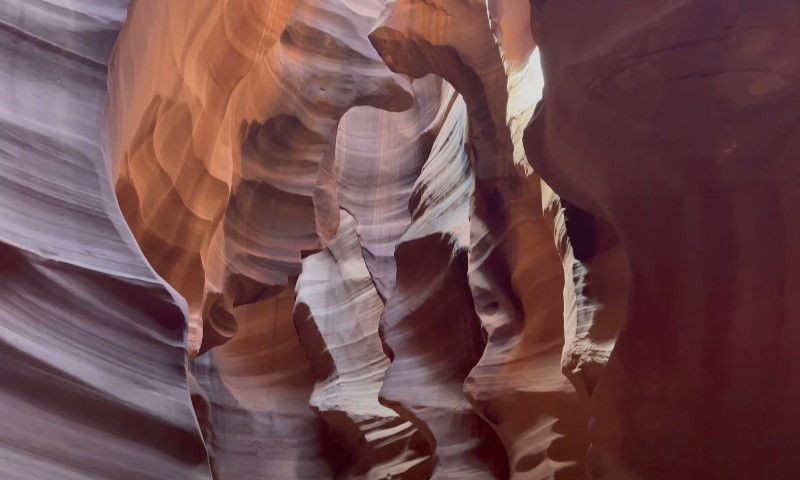
If you only have time for one slot canyon:
- Choose Upper if the light-beam photo is non-negotiable or if someone in your group prefers minimal climbing. Book the 10:30 a.m. to 1:00 p.m. slot between May and September.
- Choose Lower if you want to climb, twist, and explore without feeling rushed. Early morning slots are less crowded and more peaceful.
If you’re doing both on the same day, start early:
- Lower Antelope in the morning (cooler, less crowded).
- Upper Antelope late morning or early afternoon for the light beams.
That timing also gives flexibility in case weather or check-in delays occur.
Cultural Respect
Antelope Canyon is part of the Navajo homeland. Guides often share the canyon’s Diné names, stories, and traditions that connect their people to the land. Visitors are asked to listen respectfully, avoid touching the walls, and refrain from leaving any trash.
Even small gestures like saying thank you or learning a few words of the Navajo greeting (“Yá’át’ééh”) go a long way. Remember, you’re walking through sacred land shaped by both nature and culture.
Bottom Line
Both canyons are extraordinary, and whichever you pick will stay with you long after you leave.
- Choose Upper Antelope Canyon for classic light beams, an easy walk, and family-friendly access.
- Choose Lower Antelope Canyon for an active adventure through winding stairways and glowing sandstone.
Either way, book with a licensed Navajo operator, plan for weather flexibility, and treat the land with respect. The canyon’s curves have taken thousands of years to form, and they’ll wait for you on a safer day if rain moves in.

